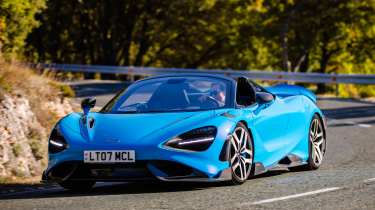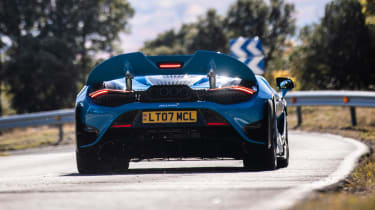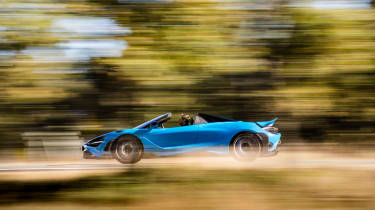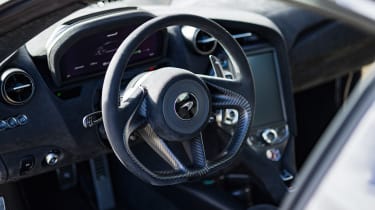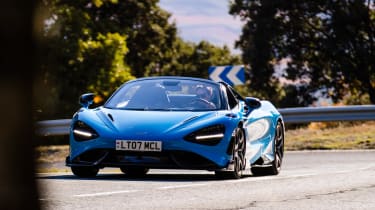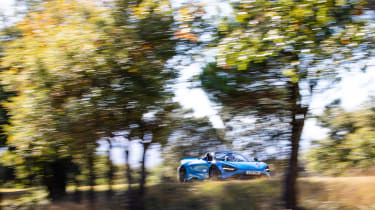McLaren 765LT Spider 2022 review – not just a drop-top 765LT, but a better 765LT
The new 765LT Spider absolutely delivers by refining the Coupe’s intense capability, creating the ultimate open-top experience
On paper the new McLaren 765LT Spider appears to be little more than a 765LT Coupe with the same folding hard top used in the 720S Spider. And even if this were to be the case, there wouldn’t be a whole lot wrong with that.
But as it happens, McLaren has gone further than it probably needed to with the Spider – to a point where it almost feels like an entirely separate model beside the Coupe; a car with its own dynamic personality, one that’s more rounded than the Coupe’s thanks to a raft of changes above and below its partially new carbon-fibre skin.
There are new damper settings all round, new active rear wing dynamics to accommodate the slight shift in the centre of gravity (rearwards) brought about by the new roof design, a different steering ratio and all sorts of fresh styling features inside and out. Plus there’s a new titanium exhaust system to further enhance the machinations of the 755bhp twin-turbo V8.
The result is a better all-round supercar than the Coupe, arguably, in that it’s a fair bit more usable overall, yet at the same time no less potent where it counts. In some circumstances, the Spider could even be the quicker of the two 765’s, and there are various reasons why.
More reviews
In-depth reviews
Reviews
- McLaren 765LT Spider 2022 review – not just a drop-top 765LT, but a better 765LT
- McLaren 720S GT3X 2021 review – a Ferrari FXX-K for less or 720S GT3 racer for more?
- McLaren 720S Spider review - a drop-top supercar without compromise?
- DMS McLaren 720S review – with 819bhp, this 720 is more powerful than a Senna
For starters, it weighs little more than the Coupe at 1388kg, which means its straight line performance remains melon-rotatingly outrageous. As in zero to 62mph in just 2.7sec with 0-124mph (200kmh) in 7.2sec. Or to put it another way, nuts.
And to make it feel even quicker than it actually is, the Spider genuinely does sound a fair bit naughtier than the Coupe thanks to its new titanium exhaust. This provides a key distinction.
Better still is the way in which McLaren has adjusted the Spider’s dynamic personality to make it more approachable, and less spiky at or near the limit. They’ve achieved this by tweaking the damper settings to be a fraction softer all round while the rear wing extends in a different way under brakes to improve stability. Again, this has made it that little bit less frenetic under big stops, especially on uneven surfaces.
The steering is also a fraction slower-geared to give it marginally less aggressive responses just off centre, and like everything else the Spider does, it works a treat.
Under no circumstances would you ever call it a softie. Instead, the Spider simply feels a touch more keyed-in to whatever road you drive it across, partly because it stays in contact with that road for more of the time.
On a track, the combination of this superior ability to ride kerbs and bumps, mated to the already mighty power of the carbon ceramic brakes and the 765’s monumental straight-line performance, mean the Spider is inevitably one of the fastest convertible cars money can buy. Add to this its increased mid-corner adjustability and even smoother gearbox responses and it’s no surprise that McLaren says the Spider is at least as quick as the Coupe around most circuits, and probably a touch faster in most hands on tracks that are bumpy in places.
But it’s on the road where it makes the best sense of all, that’s where it feels at its most natural, even though it also seems to operate in another time dimension relative to other traffic around you. Again, this makes it a subtly different prospect from the Coupe, which is probably a better track car than it is road car due to its more aggressive personality.
Either way, the Spider is a thoroughly spectacular car to drive, one that can leave you feeling quite dazed to begin with, so vast is its dynamic repertoire. But it’s also a rather lovely thing just to climb into and be in, long before you reach for the starter button.
As with the original 720S, there are two distinctly different instrument displays; one for the road, the other for track use which, when deployed, sees the entire instrument cluster rotate and withdraw into the binnacle to leave you with a thinner, more focused rev counter to look at. It’s quite some piece of theatre the first time you witness it, although in all honesty it’s not strictly necessary because it means you lose the tyre pressure and fluid temperature displays in track mode, which is entirely counter-intuitive.
The rest of the Spider’s cabin works just great. The car we drove had the optional seats from the Senna (which are a delight but are also expensive at £6250) but even without these it’s clear that the fundamental quality inside continues to get better with every new car they make at Woking nowadays. Which is a welcome discovery.
Visibility is also excellent for a convertible, hood up or down, while the management of air within the cabin is similarly tidy with the roof down. With it up the Spider feels – and sounds – to all intents like a full blown coupe. Which is nice.
Prices and rivals
Conclusion; the 765 Spider is not a cheap car at £310,500, not in any way imaginable. But it is a very, very good one indeed. Possibly the best yet from McLaren Automotive, and there have been some quite tidy ones during the last 11 years.
With Ferrari hesitating on a stripped down version of the F8 Tributo, let alone a spider variant of that hardcore model, the 765LT Spider doesn’t have much in the way of direct rivals. Lamborghini’s Aventador SVJ Roadster could be considered an alternative, but its production has now ended, leaving just the Huracán which is both significantly less powerful and only available with a solid roof in its hardcore STO form.
